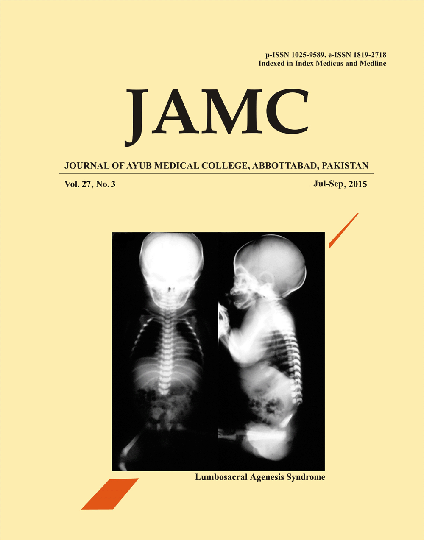CONTINUOUS VERSUS INTERRUPTED SUTURES FOR REPAIR OF EPISIOTOMY OR 2ND DEGREE PERINEAL TEARS
Abstract
Background: Performing an episiotomy is generally reserved for complicated childbirths, in cases of foetal distress, or when tearing of tissues with serious consequences are foreseen. In addition to the extent of the trauma, the surgical skill, repair after childbirth can have an important effect on the magnitude and degree of morbidity experienced by women after repair. The best technique for this repair would be that which produces less pain in the short and long term. The study was done with an objective to compare the frequency and severity of pain (slight/severe) by using interrupted and continuous methods for repair of episiotomy or second degree perineal tears. Methods: It is a randomized control trial. This study was carried out in a Gynaecology and Obstetrics department of Benazir Bhutto Hospital Rawalpindi which is a tertiary care hospital. The duration of study was six months. One hundred & thirty-eight primigravidas (69 in each group) were included in the study. Results: Majority of the patients in both groups belonged to 20-25 years age group, i.e., 48.53% (n=33) in group-A and 50% (n=34) in group-B, mean and sd, was 27.69±3.21 in group -A and 28.16±3.89 in group-B, gestation age of the patients in group-A 77.94% (n=53) and 83.82% (n=57) in group-B between 37-40 weeks of gestation. Complication of pain and its severity in both groups at 24 hours and 10th day were compared which showed no significant difference at any severity (i.e., no pain, mild moderate/severe). Conclusion: There is no significant difference in frequency and severity of pain (slight/severe) in using interrupted and continuous methods for repair of second degree perineal tears or episiotomyReferences
Graham ID, Carroli G, devies C, Medves JM. Episiotomy rates around the world; An update; Birth 2005;32(3):219-23.
Kindberg S, Stehouwer M, Hvidman L, Henriksen TB. Postpartum perineal repair performed by midwives; a randomized trail comparing two suture technique leaving the skin unsutured. BJOG 2008;115(4);472-9.
Hertrmenn K, Viswanthan M, Palmieri R, Garthehner G, Thorp J Jr, Lohr KN, Outcomes of routine episiotomy: a systematic review. JAMA 2005;293(17):2141-8.
Nsia M. Effects of episiotomy on perineal laceration in spontaneous vertex deliveries. Ann king Edward Med Uni 2005;11(4):422-5.
Javaid I, Shoaib T, Bhutta S. liberal versus restricted use if episiotomy in primigravida. J Surg Pak 2007;12(3):10-9.
Kettle C, Hills RK, Ismail KM, Continuous versus interrupted sutures for repair of episiotomy or second degree tears. Cochrane Database Syst Rev 2007;(4):CD000974.
Valenzuela P, Saiz Puente MS, Valero JL, AzorÃn R, Ortega R, Guijarro R. Continuous versus interrupted sutures for repair of episiotomy or second degree perineal tears; a randomized controlled trail. BJOG 2009;116(3);436-41.
Kettle C, Johnson RB. Continuous versus interrupted sutures for perineal repair. Cochrane database syst. Rev 2000;(2):CD000947.
Morano S, Mistrangelo E, Pastorino D, Lijoi D, Costantini S, Ragni N. A Ranomized Comparison of suturing techniques for episitomy and laceration repair after spontaneous vaginal birth. J Minim Invasive Gynaecol 2006;5(5):457-62.
Kettle C, Hills RK, Jones P, Darby L, Gray R, Johanson R. Continuous versus interrupted perineal repair with standard or rapidly absorbed sutures after spontaneous vaginal birth: a randomizes controlled trial. Lancet 2002;359(9325):2217-23
Downloads
Published
How to Cite
Issue
Section
License
Journal of Ayub Medical College, Abbottabad is an OPEN ACCESS JOURNAL which means that all content is FREELY available without charge to all users whether registered with the journal or not. The work published by J Ayub Med Coll Abbottabad is licensed and distributed under the creative commons License CC BY ND Attribution-NoDerivs. Material printed in this journal is OPEN to access, and are FREE for use in academic and research work with proper citation. J Ayub Med Coll Abbottabad accepts only original material for publication with the understanding that except for abstracts, no part of the data has been published or will be submitted for publication elsewhere before appearing in J Ayub Med Coll Abbottabad. The Editorial Board of J Ayub Med Coll Abbottabad makes every effort to ensure the accuracy and authenticity of material printed in J Ayub Med Coll Abbottabad. However, conclusions and statements expressed are views of the authors and do not reflect the opinion/policy of J Ayub Med Coll Abbottabad or the Editorial Board.
USERS are allowed to read, download, copy, distribute, print, search, or link to the full texts of the articles, or use them for any other lawful purpose, without asking prior permission from the publisher or the author. This is in accordance with the BOAI definition of open access.
AUTHORS retain the rights of free downloading/unlimited e-print of full text and sharing/disseminating the article without any restriction, by any means including twitter, scholarly collaboration networks such as ResearchGate, Academia.eu, and social media sites such as Twitter, LinkedIn, Google Scholar and any other professional or academic networking site.










